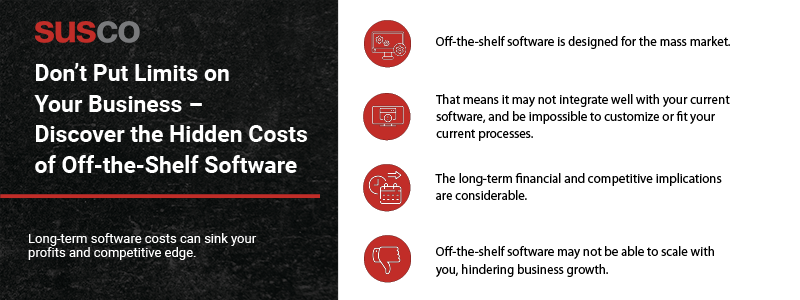Long-term software costs can sink your profits and competitive edge

Off-the-shelf software is mighty tempting. After all, it provides the fastest, least expensive way to gain efficiency, improve productivity, and give your insurance adjusting firm a competitive edge.
Wrong!
This thinking is short-sighted at best and business-crippling at worst, negatively impacting long-term finances and growth. It’s a myth that commercial off-the-shelf software will get you where you want to go. It’s also a myth that custom software is cost-prohibitive.
It’s a matter of looking ahead, not only at the upfront costs but the long-term financial burden, understanding that off-the-shelf means doing things someone else’s way instead of forging the path that serves your business and your profitable future best.
What’s needed is an understanding of the true impact – both financial and otherwise – of this “easy” solution. What you discover may surprise you as we look at the hidden costs of off-the-shelf software.
Initial costs vs. long-term expenses
That generic XYZ software looks like it has everything you need – at a nice price – to set your business up for growth and success.
But the purchase price doesn’t tell the complete financial story. Here are the real costs after purchase:
- License fees: These are the charges you pay for the privilege of using the software. These fees can significantly impact the overall price you pay. Software vendors often determine fees based on the scale of your operation, meaning that if you have a sizable business, you might incur substantial costs for what are essentially basic tasks. These fees are typically paid annually and encompass the entire software package, regardless of whether you utilize all its features.
- You’re paying for things you don’t need: Off-the-shelf software is like the Swiss Army knife of the digital world. You might need the knife and corkscrew, but that toothpick? You may not need every feature the software provides, but you’ll be paying for them anyway.
- It’s not really plug-and-play: You need an experienced IT team to successfully implement off-the-shelf software. It might need time-consuming and costly workarounds to fit your business processes. Often, your team will have to force-fit the solution to make it do what you want, even if it isn’t designed to do it.
- It might not play well with your legacy software: You likely have multiple systems and teams – accounting, marketing, production, sales, etc. – and your new software may not be compatible, which means that instead of integrating, you’re just adding another silo.
When you go off-the-shelf, count on adjusting your business processes around the software. This may hinder adoption, increase staff frustration, and create a poor customer experience. If no one uses the pre-built solution, you’ve wasted your money.
You plan to grow your business, right?
As your business expands, so does the demand placed on your software. That off-the-shelf solution you bought last year likely won’t serve you well. You’ll face system crashes, operational inefficiencies, and issues with performance.
Integration and scalability are essential for growth and seamless operations. That is something off-the-shelf software can rarely accomplish. As your business grows, you have no control over changes and upgrades made by the vendor.
After all, that off-the-shelf solution is designed for a mass market and their needs. As a result, it will rarely meet yours.
What about security and compliance?
One of the hidden costs of off-the-shelf software centers around security. Hackers love commonly used software. They know and can easily exploit vulnerabilities to gain access to data from your company and thousands of others.
A single data breach can cost you your entire business. A 2023 report found that the financial cost of a data breach has reached an average of $4.45 million. While compromised credentials accounted for 19% of breaches, the largest increase came from system errors.
Data breaches have their own hidden costs: reputational damage and potential enforcement action by the Federal Trade Commission for violating privacy rights or failing to maintain proper security. And almost everything you do carries compliance implications if you work in a regulated industry, such as legal, financial, or healthcare. Off-the-shelf software isn’t designed to facilitate or ensure compliance without pricey software customization expenses.
In summary…
The hidden costs of off-the-shelf software are many.
- It’s more expensive over time to make it compatible with your processes, with licensing fees and internal expenses, and you may be charged for upgrades.
- It’s almost impossible to change without a great deal of expense.
- You have no control over features and upgrades.
- You get either more or less than you need.
- Integration issues are rife and difficult to solve if they occur.
And, because it’s a mass-market, generic, one-size-fits-all product, it’s unlikely to mesh with your current processes. Be aware that not every commercial software comes with included support. You have no or limited support unless you pay additional fees.
What happens if the software vendor decides to stop supporting the product at all?
The lesson here is that what may appear less expensive initially can cost you dearly – in more ways than you can count – over time.
Assess carefully
The bottom line is business value when looking at off-the-shelf software and long-term software costs. What will drive your business forward? Weigh all the pros and cons, not just the financial ones – look at the soft costs as well, including the effect on your processes, people, and competitive advantage.
When you decide a custom software solution is right for your firm, contact Susco. We’ll design, build, implement, and train on software that precisely meets your firm’s needs, with nothing you don’t want. Get faster, better, stronger, and increase revenue.
For over a decade, our dedicated team of web and application developers has built custom solutions that perfectly align with business goals. Discover what we can do for you. Get in touch today so we can schedule your free one-hour assessment